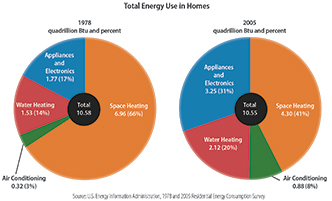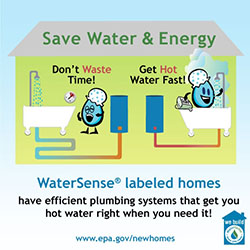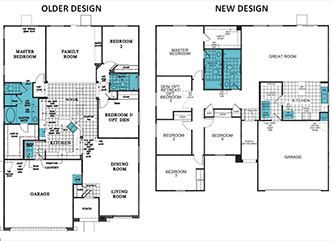The WaterSense Blueprint
The WaterSense Blueprint: Issue I, Winter 2014
The WaterSense Blueprint is a quarterly update dedicated to news and events related to WaterSense labeled new homes. Sign up to receive The WaterSense Blueprint and get WaterSense news delivered right to your Inbox. You can also help spread the word by distributing Blueprint (4 pg, 360K, About PDF) to builders and developers looking to incorporate water efficiency into their projects.
In This Issue:
- Welcome to Blueprint!
- Technical Corner: Efficient Hot Water Distribution Systems Save Water and Energy
- NEW! Infographic on Efficient Hot Water Distribution Systems!
- Builder's Beat: Q&A With KB Home's Jacob Atalla
- Share the Savings: Promote Your WaterSense Labeled Homes on Social Media
- Calendar of Events
Welcome to Blueprint!
Welcome to the inaugural issue of Blueprint, which brings you the latest information and updates on the WaterSense New Homes program. In this first issue, we focus on an aspect of WaterSense labeled new homes that really sets them apart from traditional new homes—the efficient hot water distribution system. In homes built to meet the WaterSense specification, hot water distribution systems save residents water, energy, time, and money. This issue's "Technical Corner" outlines why an efficient hot water distribution system is important, and our Q&A with KB Home Senior Director of Sustainability Initiatives Jacob Atalla includes tips for incorporating an efficient hot water distribution system into building design. You'll also find a new infographic illustrating the benefits of an efficient hot water distribution system that you can use on websites and social media.
We want the Blueprint to cover the topics you're most interested in, so don't hesitate to let us know what future topics you'd like us to address. Email those and other thoughts to watersense@epa.gov.
Happy reading and building!
Technical Corner:
Efficient Hot Water Distribution Systems Save Water and Energy!
We all spend a large portion of our lives waiting, and long waits for hot water that waste water, energy, and time are a common homeowner complaint. Builders can reduce the wait time for hot water by constructing WaterSense labeled new homes with cost–effective plumbing systems that will save water and energy while increasing customer satisfaction.
Falling Behind on Efficiency
We have made great strides in building science technology over the past few decades. In fact, we've done such a great job that the energy used to heat and cool the air no longer makes up the majority of our homes' energy use. Unfortunately, we haven't seen similar gains when it comes to hot water. As a result, water heating still represents a discrete piece of the energy pie where we can improve energy efficiency.

It can be troubling to think that we're actually using more energy for water heating than we did 30 years ago. For many tasks, such as showering and clothes washing, we're using much less hot water due to the development of more water-efficient, high-performing products. Additionally, we also have much more efficient hot water heaters. However, the energy used for water heating over the last 30 years has actually increased. Why aren't we seeing any improvements? In many cases, it's due to the fact that we are not efficiently moving water from the water heater to the fixture. Much the way the inefficient ductwork can limit the efficiency of a home's HVAC system, inefficient plumbing layout can limit the efficiency of a hot water system. The following are key considerations when designing water- and energy-efficient plumbing systems for homes:
- Generating hot water: Improvements have been made in developing efficient water heaters, but a lot more progress can be made on using them. Builders can start by encouraging homeowners to select ENERGY STAR® qualified water heaters that are more energy-efficient than standard models, and making sure customers understand the lifetime operating costs of more efficient versus less efficient water heaters.
- Distributing water: As hot water travels through pipes and sometimes sits for hours on the way to the point of use, it loses heat. When hot water moves through pipes that take circuitous routes, have a larger diameter than is necessary, or have excessively long runs (a common problem, since we tend to make homes larger today than we did 30 years ago ), our plumbing systems waste both energy and water. They waste energy because the water that was once hot is allowed to cool, and waste water while users wait for hot water to arrive. WaterSense has created a Guide for Efficient Hot Water Delivery Systems to help builders and plumbers better understand and implement efficient plumbing system designs that save water, energy, and time waiting for hot water.
- Using water: Plumbers can help make the use of water more efficient by encouraging their customers to use WaterSense labeled products, such as faucets and showerheads, that are independently certified to perform as well or better than traditional models while using less water.
Selling Systems That Make Sense
Since 2009, new homes that meet the U.S. Environmental Protect Agency's (EPA's) criteria for water efficiency and performance have been eligible to earn the WaterSense label. Efficient delivery plays such a big role in household water and energy use that the WaterSense new home specification requires a hot water delivery system that reduces both the energy and water used when compared to traditional new homes. The system in a WaterSense labeled new home minimizes water loss by storing no more than 0.5 gallons of water between the hot water source and any hot water fixture. The hot water source is typically a water heater, but it can also be a recirculation line. In addition, any recirculation system in a WaterSense labeled new home must be demand-initiated, drawing hot water into the recirculation loop only when needed.
Careful planning and thoughtful design can provide efficient distribution systems without significantly increasing costs or installation time. Installing a high-performing plumbing system ultimately saves the homeowner money and allows builders to deliver a better product to their customers. After all, nobody likes paying to heat water they'll never get to use, and nobody likes waiting for their morning shower.
Better Planning, Better Plumbing
An efficient hot water delivery system has tangible benefits. For homeowners, the convenience of hot water when it's needed combined with reduced water and energy costs is a win-win. For builders, an efficient hot water delivery system can reduce material and installation costs, as well as call-backs.
Learn more about EPA's new home specification and hot water delivery system efficiency.
NEW! Infographic on Efficient Hot Water Distribution Systems!

Are you looking for an easier way to communicate the benefits of efficient hot water distribution systems to your customers? Use this infographic on websites and via social media to illustrate for your customers that hot water distribution systems meeting WaterSense criteria will save water, energy, time and money.
Builder's Beat: Q&A With KB Home's Jacob Atalla
To learn more about how a builder approaches including an efficient hot water delivery system into home design and building, WaterSense went straight to the source: Jacob Atalla, Senior Director of Sustainability Initiatives at KB Home. KB Home is a three-time WaterSense Builder Partner of the Year.
Q: What strategy does KB Home typically use to meet the WaterSense criteria for hot water delivery systems?
A: KB Home is focused on increasing homes' water and energy efficiency without reducing their comfort or durability, so we pay close attention to hot water delivery systems starting at the early stages of floor plan design. We locate the highest hot water demands—the kitchen, bathrooms, and laundry areas—as close as possible to the hot water heater. By designing our homes with kitchens and baths concentrated in one area of the house, we vastly reduce the length and complexity of the required plumbing runs. The example below demonstrates what a difference centralized plumbing can make. In the older KB Home design, plumbing is located in five different areas of the house, while the new design only requires two.

We then couple the centralized floor plan design with the structured plumbing principles that optimize the plumbing design with miniature manifolds and pipes with smaller radiuses. These effectively create a network of smaller "branches and twigs" that distribute hot water from the main "trunk" while maintaining more heat. While some larger floor plans might still require an on-demand hot water recirculation pump, smart design can help increase hot water efficiency dramatically.
Q: What is your planning process?
A: To optimize the hot water delivery system at the lowest construction cost, KB Home usually first engages the architect and the plumber to try to achieve WaterSense's hot water criteria without the addition of an on-demand hot water recirculation pump. We also engage the licensed certification provider that will be inspecting and labeling the home early on in the process. A knowledgeable provider or plumber can use the WaterSense program tools to evaluate whether a plumbing design will successfully meet WaterSense's minimum requirements for hot water delivery. If structured plumbing and an effective floor plan layout aren't enough to create efficient hot water delivery, we evaluate on-demand hot water recirculation pumps that are available in the local market.
Q: How does this strategy benefit the bottom line of your company and your customers?
A: Getting hot water more quickly and efficiently throughout a WaterSense labeled new home is a big differentiator for us compared to resale homes. As a builder of water-efficient homes, we also often have better positioning with municipalities, especially those in drought-prone areas. Through efficient early design, we reduce the required length of the plumbing and likewise reduce the cost to build the home—savings that we can pass on to our home buyers in the form of lower prices. In addition to the initial home cost, homeowners benefit from monthly utility bill savings. Getting hot water faster means less energy required to maintain heat and less water and time wasted waiting. These savings get reflected in homeowners' utility bills each month, thus improving their financial return on investment. Offering home buyers the ability to save water, energy, and money is a win-win proposition; we deliver a better home that can save as much as 50,000 gallons of water per year and $600 in reduced water and energy bills annually, without sacrificing any living experience.
Q: What advice would you give other builders when considering WaterSense's hot water requirement?
A: Start early! As I discussed earlier, KB Home looks at efficient plumbing during the initial design stages, which gives you more flexibility to meet WaterSense's hot water requirement. WaterSense's Guide for Efficient Hot Water Delivery Systems lists different paths to meet the WaterSense criteria for hot water delivery. It's a great starting point for evaluating a builder's best options to meet WaterSense's minimum requirements for hot water delivery. To ensure a successful outcome, it's best to check on the hot water delivery throughout the different stages of homebuilding, starting with the design stage.
Share the Savings: Promote Your WaterSense Labeled Homes on Social Media
Combine our new infographic with these sample social media posts to help customers warm up to the water-saving benefits of WaterSense labeled new homes' efficient hot water delivery systems.
- Shivery start to your shower? Our @EPAwatersense labeled new homes deliver hot water efficiently with less water, time, and energy.
- The average household wastes 3,650 gallons+ per year waiting for hot water. Our homes meet @EPAwatersense criteria so you're sure to save.
- Quit waiting for your shower to get hot! We build @EPAwatersense labeled homes with efficient hot water delivery.
- Shiver me timbers no more! Hop into a hot shower in our @EPAwatersense labeled homes & save $, water, time, & energy.
Facebook
What were you doing this morning while you waited for your shower water to heat up? Shivering? Maybe thinking about all the water, energy, and money running down the drain? Studies show that the average home wastes more than 3,650 gallons of water per year waiting for hot water to reach the tap. Saving you both drops and watts, WaterSense labeled new homes are built to meet EPA's criteria for hot water delivery. These efficient hot water distribution systems deliver hot water without the wait so you can start feeling the heat a lot faster.
Learn more at www.epa.gov/watersense/new_homes/ and contact us at [insert your company/contact information] to cut the shower wait and waste in your next home.
Calendar of Events
March 26, 2014: "Understanding the WaterSense Labeled Home" Symposium (Dallas, Texas)
Texas A&M AgriLife Research and Extension Center-Dallas has partnered with EPA Region 6 and WaterSense to host a symposium for builders, municipalities, city council members, city code enforcement professionals, city planners, and landscape architects on understanding the nuances of building and supporting WaterSense labeled new homes in your community. This symposium will increase awareness of the WaterSense New Homes program and other voluntary partnership programs to promote the building of water-efficient homes in North Texas that are in harmony with other green home energy-saving efforts. Register![]() for the symposium to attend and find out more.
for the symposium to attend and find out more.
March 30 – April 2, 2014: American Water Works Association Sustainable Water Management Conference (Denver, Colorado)
WaterSense representatives will present the latest news and information on WaterSense labeled new homes. Register![]() for the conference to attend and find out more.
for the conference to attend and find out more.
April 25, 2014: Q1 2014 WaterSense Quarterly Reporting Deadline
Make sure your licensed certification providers report to WaterSense on any of your homes that earned the WaterSense label during the first quarter of 2014. The Q1 2014 reporting deadline is Friday, April 25.




